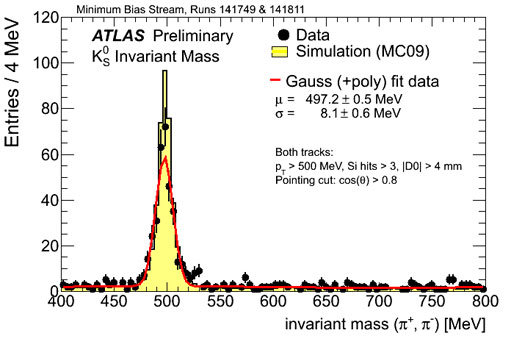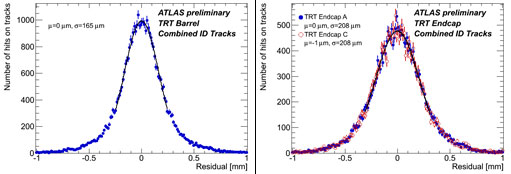
ATLAS e-News
23 February 2011
Status snapshot
14 December 2009

Ks reconstructed from two tracks selected in Inner Detector with pT > 500 MeV and a few selection cuts as shown to reduce the background.
Physics tells us that time is a relative entity. Proverb, Smokey Robinson, and experience insist that time flies when we’re having fun. Either way, things have been progressing apace over the last few weeks since the first beam splashes on November 20th, and there is much to report and even more to anticipate.
As we go to (electronic) press, ATLAS has so far recorded a total of about 700,000 collision events at beam injection energy, 900 GeV, and upwards. As soon as the LHC people had got to grips with their machine and had the beams well under control, the delicate silicon detector regions – which had previously been off or at reduced voltage to protect them from radiation damage from straying beams – were brought fully into the run. Since Sunday December 6th, about 450,000 collision events have been recorded with the full ATLAS detector.
Also on December 6th, the LHC upped the number of proton bunches per beam from two to four, but found that initially Beam 2 was decaying after only 30 minutes. Run Coordinator Christophe Clement and others who had spent all night in the Control Room were snatched from the arms of sleep at 7:00 – just 30 minutes after they’d agreed to call it a night – when the Beam 2 lifetime issues were finally resolved and collisions were back on the cards.

Residuals (i.e. difference between reconstructed and recorded location) for hits in TRT barrel (left) and end-caps (right) in collision data after a first calibration round. The Barrel was calibrated using cosmic data but due to its geometry (vertical straws), very few cosmic tracks were recorded in the TRT end-caps but already, the resolution is almost as good as in the barrel.
In general, beam lifetime has been good; up to several hours in some cases. The fill intensity of the proton bunches has been steadily increased; now reaching about 15 billion protons per bunch (1.5 x 1010) at the start of the fills, at which time ATLAS records a rate of Minimum Bias collision events of up to 13 per second (13 Hz). Interesting results so far include di-jet candidates, K0s, π0, Λ, and muon candidates.
Last Tuesday night (December 8th), the machine ramped for the first time to 1.18 TeV per beam, officially making the LHC the highest energy accelerator on Earth. A few minutes of 2.36 TeV collisions were recorded, beginning at 20:40, and a total of 120 collision candidate events were identified from that period. In the early hours of Monday December 14th, the machine provided a longer period of 2.36 TeV collisions. Over two hours ATLAS collected around 12 thousand collision candidates, and work to analyse and interpret these began in earnest.
The mood of collaborators on site and around the world seems to be one of contained excitement. “ATLAS has worked extremely well, from data-taking at the pit to the very fast production of performance plots,” says Spokesperson, Fabiola Gianotti.
From the afternoon of December 16th, the LHC will be switched off. The plan for ATLAS until then is to collect as many collisions at 900 GeV as possible – a magic million is the aim – for detector performance and Minimum Bias studies. Shifts will continue in the Control Room until the 18th, and SLIMOS will run 24 hours a day right through the shut down.
Between December 21st and January 4th, most of ATLAS will be off, but the infrastructure will remain on. Work to be done in the cavern – including finding a permanent fix for the problem of warming in the Toroid magnet current leads – will take place between January 4th and 25th. Sub-systems, cooling, and shifts will gradually be re-started until the start of February, at which point all shifts will resume 24/7 and the magnetic field will return. Beam is expected on or after February 14th.

Ceri PerkinsATLAS e-News
|